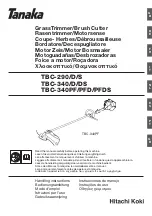
- 21 -
2 STROKE INTERNAL COMBUSTION ENGINE
(2T)
WARNING! All operations indicated below
must be carried out with the engine switched
off and the switch in the “stop” position.
WARNING! Always wear safety gloves and
safety goggles.
The machine is sold without fuel, which is a
mixture of petrol and lubricating oil
WARNING! The engine works exclusively with
an oil-petrol mixture obtained using oil in the
percentage indicated on the specification
sheet. If this mixture is not used irreparable
damage will be caused to the engine with
immediate loss of warranty.
PREPARING THE MIXTURE
Use a synthetic oil such as JASO FC GRADE
or ISO EGC GRADE that ensures better perfor-
mance, reduced smoke emission and longer
engine life.
How to prepare a petrol-oil mixture with 3%
oil (1:33)
Use a container and a measuring cup (not inclu-
ded) to mix 33cc of oil (0.033 litres) in 1,000
cc (1 litre) of petrol. Only unleaded car petrol
should be used (or EuroSuper) with a minimum
90 octane.
Shake the mixture well before use. It is advisable
to prepare only the quantity of mixture necessary
to fill the tank.
Storing the mixture for long periods of time
results in its rapid deterioration. We recommend
adding specific additives to prevent the mixture
from deteriorating over time, which would result
in engine malfunction and problems switching
the machine on.
Store the petrol and the oil in suitable, approved
containers, in a safe place, and out of the reach
of children.
Instructions for preparing the petrol-oil mixture
with 3% oil using the container supplied (Fig. F)
Fill container with petrol up to level marked 1.30.
Add oil up to level marked 600. Close the cap
and shake.
FILLING UP WITH FUEL
WARNING! Risk of fire and explosion. Refill
with fuel with the engine off, in a well-ventila-
ted outdoor area. If the fuel has splashed onto
the machine or pavement, wipe it thoroughly
before starting the machine.
WARNING! Risk of fire and explosion. Do not
pour fuel onto hot engine surfaces.
Only use the oil-petrol mixture as specified
above. Never use petrol without oil, dirty or old
fuel, or petrol blended with alcohol.
Do not allow water or dirt to enter the tank.
1.Position the machine on a stable, level surface.
2.Unscrew the tank cap
(Fig. A pos.11)
, turning
it anti-clockwise.
3.Fill the tank
(Fig. A pos.17)
without letting it
overflow, using a large funnel (not included).
Follow any instructions placed on the tank; if
there are none, keep the maximum level 3 cm
below the rim.
4.Tighten the cap by turning it clockwise.
5.Wipe with a cloth any drops of petrol spilled
on the machine.
SWITCHING ON AND OFF
WARNING! Before starting the machine, it is
compulsory to wear all personal protective
equipment (not included), mentioned under
the chapter “Safety Warnings”.
WARNING! Do not start the engine if the
protection of the cutting element is missing.
WARNING! While starting up the machine, the
cutting device could start rotating. Therefore,
keep a safe distance.
WARNING! Before starting the engine, ensure
that you have completed the operations reque-
sted in the previous chapters for initial start-up
of the machine and engine.
WARNING! Before starting the engine check
that the tank is suitably full.
The machine is equipped with a centrifugal
clutch; with the engine idling (not accelerated)
the cutting devices do not work. In order to
stop the cutting device rotation, simply release
the accelerator so that the engine slows to idle
speed in just a few seconds. If the cutting ele-
ment rotates while the engine is idling, contact
an authorised service centre and have them
check the machine.
Closely observe
Fig.G
and memorise all the
controls located on the control handle.
The accelerator control is equipped with a safety
lock lever intended to prevent unintentionally
starting the cutting device.








































